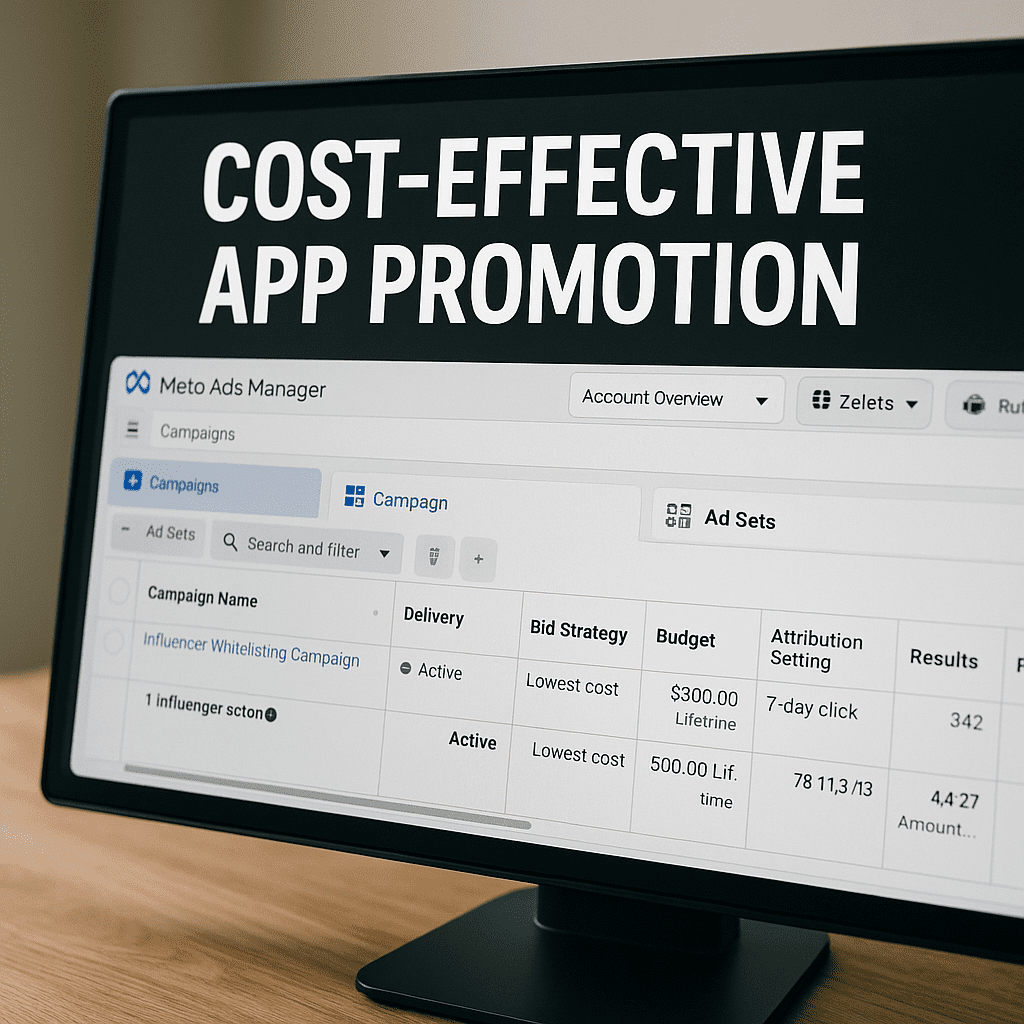
Cost-Effective App Promotion: A Practical Guide to Influencer Whitelisting Campaigns on Paid Social
In 2025, mobile app marketers face escalating user acquisition costs and fierce competition. Traditional paid channels often struggle to deliver authentic engagement, driving up cost-per-install (CPI) and eroding return on ad spend (ROAS). Influencer whitelisting has emerged as a leading solution: brands run paid ads from an influencer’s account, leveraging built-in trust and reach while retaining full control over targeting, creative assets, and budget. This guide, written from the perspective of a CMO at a top app growth agency, covers every step of planning, launching, and optimizing whitelisting campaigns that deliver sustained CPI reductions and higher lifetime value (LTV).
What Is Influencer Whitelisting?
Influencer whitelisting is a partnership model where a brand gains authorized access to an influencer’s social account to run paid ads on behalf of the influencer. Instead of ads coming from your brand page, they appear natively as sponsored content from the influencer—combining organic credibility with precise ad targeting.
- Ads tap into the influencer’s established trust, driving 30–50% higher click-through rates versus brand-only campaigns.
- Brands can build custom and lookalike audiences from the influencer’s follower base.
- “Dark posts” enable A/B tests and tailored messaging without cluttering the influencer’s public feed.
By merging creator authenticity with programmatic control, whitelisted ads unlock cost efficiencies for app installs, in-app events, and retargeting campaigns.
Why Influencer Whitelisting Delivers ROI
Influencer whitelisting delivers savings and performance gains in three key areas:
- Lower CPI: Ads from trusted creators feel less intrusive. Benchmarks from Business of Apps show CPIs drop 20–35% when using whitelisted ads on Meta and TikTok versus direct brand buys.
- Higher retention: Users acquired via authentic creator content engage 15% longer and demonstrate 12% higher Day-7 retention compared to standard ad channels.
- Scalability: Centralized ad controls let you deploy multiple variants across dozens of influencers, optimizing by creative, audience segment, and region from one dashboard.
Step-by-Step: Running Influencer Whitelisting Campaigns
1. Identify and Vet Influencers
- Match demographics: Use audience insights to ensure an influencer’s followers align with your app’s user personas (age, location, interests).
- Engagement audit: Aim for 2–5% engagement rates. Filter out inflated metrics with tools like SocialData.io or HypeAuditor.
- Content alignment: Review past posts for brand fit and compliance with platform policies (FTC disclosures, community standards).
2. Negotiate Whitelisting Terms
- Scope of access: Define ad account permissions, campaign duration, creative approvals, and reporting cadence.
- Compensation model: Combine a base fee with performance incentives (CPI targets or install milestones).
- Usage rights: Secure the right to reuse top-performing creative across other channels or future campaigns.
3. Obtain Platform Permissions
- Meta (Facebook & Instagram): Influencer grants your Business Manager ad account “Advertiser” access to their page or profile in Meta Business Manager.
- TikTok Spark Ads: Creator generates an authorization code in the TikTok Ads Manager. Paste the code in your account to activate whitelisting.
- Snapchat & YouTube: Similar access flows require channel linking or OAuth permissions via each platform’s business portal.
Always confirm permissions at least 48 hours before campaign launch to troubleshoot access errors.
4. Launch, Test, and Optimize
- Creative variants: Develop 3–5 ad concepts per influencer—mix product demos, testimonials, and ‘day-in-the-life’ formats.
- Audience segmentation: Deploy ads to custom audiences (past engagers), lookalikes (1%–3%), and retargeting pools for lapsed users.
- Performance KPIs: Track CPI, click-through rate (CTR), install-to-registration rate, and Day-7 retention in real time.
5. Analyze, Scale, and Iterate
- Data-driven budget shifts: Move spend to top-performing creatives and influencer partners daily.
- Automated rules: Use rules in Meta Ads Manager or TikTok’s API to pause underperforming ads once CPI or CTR thresholds breach set limits.
- Scalability plan: Expand into new regions or verticals once a model influencer’s audience shows consistent ROI.
Complementary Tactics for 2025 App Growth
- App Store Optimization: Enhance metadata, test A/B screenshots, and localize listings. Use ASO strategies to boost organic conversions by 20–30%.
- Paid User Acquisition: Combine whitelisting with Google UAC and Apple Search Ads for broad reach and channel diversification.
- Content Marketing: Publish data-driven blog posts, tutorials, and reviews. Discover content marketing solutions that generate quality leads at lower costs.
- OEM Partnerships: Preinstall or feature apps on device load screens for high-quality, fraud-resistant installs—ideal for utility and finance verticals.
- Retention Campaigns: Use push notifications, in-app messaging, and drip email flows triggered by install source to boost Day-30 retention above 25%.
Key Metrics: Measuring Campaign Success
- Cost Per Install (CPI): Aim for a 20–35% reduction via whitelisted ads versus brand-owned campaigns.
- Return on Ad Spend (ROAS): Compare ad spend to in-app revenue. Target a 4x ROAS within 30 days.
- Lifetime Value (LTV): Optimize for users whose revenue exceeds acquisition cost within 60–90 days.
- Retention Curves: Analyze cohort retention at Day 1, Day 7, and Day 30 to identify drop-off triggers.
Best Practices and Common Pitfalls
- Maintain transparency: Ensure all ads include proper influencer disclosures to comply with FTC guidelines.
- Avoid over-saturation: Rotate creative every 7–10 days to mitigate ad fatigue in high-frequency audiences.
- Quality over quantity: Prioritize influencers with genuine engagement over those with inflated follower counts.
- Data hygiene: Regularly audit audience lists and ad account permissions to prevent leaks or unauthorized spending.
Conclusion
Influencer whitelisting on paid social stands out in 2025 as a cost-effective channel for driving authentic app installs and sustainable growth. By integrating whitelisted ads with robust App Store Optimization, targeted paid acquisition, and strategic OEM partnerships, growth teams can lower CPI, boost retention, and achieve superior ROAS. For tailored campaign planning and execution, partner with Admiral Media to unlock proven frameworks and data-driven insights.
